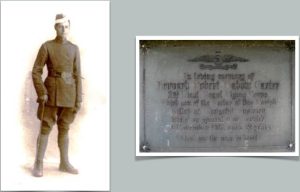19th (Training) Squadron, Royal Flying Corps

Bernard Robert Hadow Carter was the third son born to the Rector of Slimbridge, Reverend James Octavius Holderness Carter and his wife Beatrice Helena (née Stone). He was born on 21 October 1898 at Headington near Oxford, where his father was conducting his ministry. By the time of the 1911 census the family home was the Rectory at Slimbridge.
Bernard was educated at Magdalen College School, where he was a chorister and St Edward’s School, Oxford, where he was a prefect, Captain of the Boats and a Serjeant in the Officer Training Corps (OTC).
According to reports in the Gloucestershire Journal (10 and 24 November 1917), he had attested for military service as soon as he could and had joined the Inns of Court OTC. Following acceptance into the Royal Flying Corps he soon qualified as a pilot and gained his ‘wings’.
According to his Service Record in the National Archives, he joined the No 1 School of Aeronautics on 17 May 1917 and was appointed Temporary Second Lieutenant on probation on 15 June 1917.
He moved from the School of Aeronautics to 25 Training Squadron (TS) on 16 June 1917 and four days later to 12 TS. He remained with them until moving to 19 TS (based at Hounslow, (London) on 12 September 1917. On the 21st of that month he was promoted to Flying Officer.
According to research undertaken by Slimbridge Local History Society, for their booklet called “Slimbridge Remembers” published to coincide with the centenary of the start of the Great War, 19 TS were ordered to provide a flight of six Airco DH4 aircraft to the Royal Naval Air Service airship base at Llangefni, Anglesey. The airships were present to provide anti-U Boat reconnaissance over the Irish Sea. The DH4 was a day bomber and the RFC pilots were to be an additional counter to the U boat menace and gain experience in daylight bombing.
The DH4s took off on 7 November 1917, with Carter piloting aircraft A7654.
Over North Wales they encountered strong winds, rain and low cloud and four of the aircraft landed at Shotwick airfield (later RAF Sealand). Carter’s aircraft continued, alongside another. The latter decided to attempt a landing at Lavan Sands, near Bangor, which was successful but attempts by the crew and local farmers to salvage the aircraft from the incoming tide were unsuccessful. Carter and his observer, Corporal Harold Smith, pressed on to Llangefni and at about 11am attempted an approach.
Reports differ as to the circumstances which led to the crash of DH4 A7654: one states the aircraft stalled whilst at about 300 feet up and making a turn to land; another that Carter had shut down the engine and was circling over the aerodrome when a gust of wind upset the machine which fell and was wrecked: Second Lieutenant Carter was thrown against a wall and killed but Corporal Harold Smith (either an observer or ground crew being taken on a flight) escaped with only a severe cut.
An inquest was held on 9 November and a qualified officer, Flight Lieutenant D T B Williams gave evidence as he had witnessed the crash. He attributed the accident to being caused by an overly sharp turn in a gusty wind made by an inexperienced pilot.
A letter from Carter’s commanding officer was quoted in the Gloucestershire Journal of 24 November 1917 and it stated:-
“He was engaged on special duty; having been selected as one of my best pilots to go on this special mission … I had asked for him to be posted to my squadron as an assistant instructor and he had been posted in that capacity”
Second Lieutenant Carter’s body was brought back to Slimbridge by train for burial. The Dursley Gazette recorded that it arrived at Coaley Junction Station where it was met by a firing party from Rendcomb and taken to Slimbridge Parish Church by road. His grave is marked, unusually, by a plaque attached to the church wall. This states that he died at Llangefni, Angelsey ‘whilst on special war service’ and that he was aged 19. The plaque was commission by his father Canon Carter, who also commissioned a carved wooden calvary sited on the wall of the chancel, near to the plaque.
In its report of the funeral the Dursley Gazette stated:
Lieutenant Carter is remembered as having a lovable personality, warm and engaging and being popular with everyone. He was highly thought of by his fellow officers who believed his death cut short a promising career.
Researched by Graham Adams 18 March 2016 with acknowledgement to a Slimbridge Primary School website for the photo, Slimbridge Local History Society’s book Slimbridge Remembers and the Great War Forum website for certain other details.)
